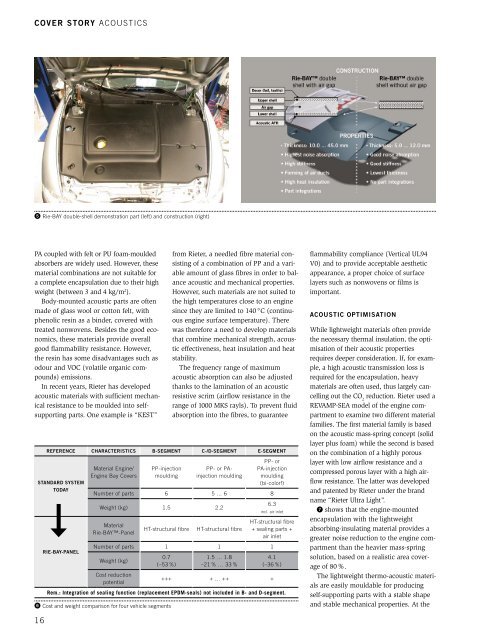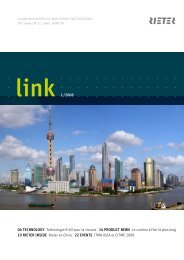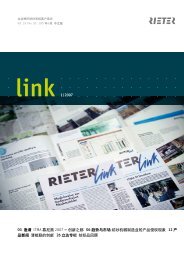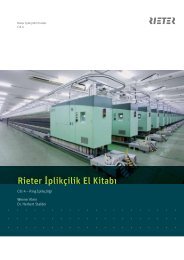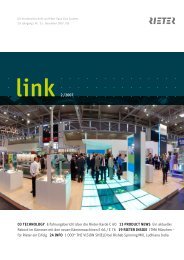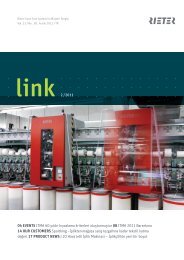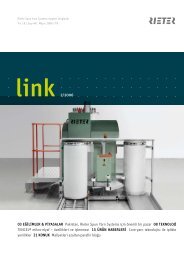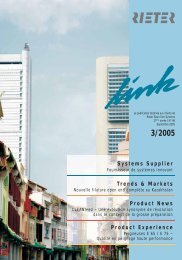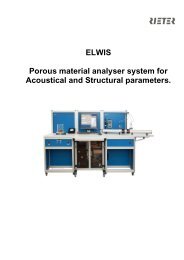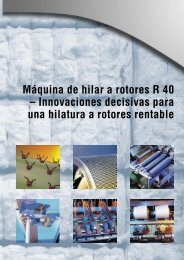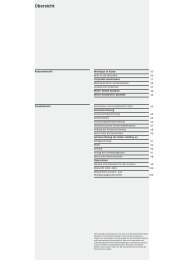Cover Story ACOusTiCs - Rieter
Cover Story ACOusTiCs - Rieter
Cover Story ACOusTiCs - Rieter
You also want an ePaper? Increase the reach of your titles
YUMPU automatically turns print PDFs into web optimized ePapers that Google loves.
<strong>Cover</strong> story <strong>ACOusTiCs</strong><br />
5 Rie-BAY double-shell demonstration part (left) and construction (right)<br />
PA coupled with felt or PU foam-moulded<br />
absorbers are widely used. However, these<br />
material combinations are not suitable for<br />
a complete encapsulation due to their high<br />
weight (between 3 and 4 kg/m 2 ).<br />
Body-mounted acoustic parts are often<br />
made of glass wool or cotton felt, with<br />
phenolic resin as a binder, covered with<br />
treated nonwovens. Besides the good economics,<br />
these materials provide overall<br />
good flammability resistance. However,<br />
the resin has some disadvantages such as<br />
odour and VOC (volatile organic compounds)<br />
emissions.<br />
In recent years, <strong>Rieter</strong> has developed<br />
acoustic materials with sufficient mechanical<br />
resistance to be moulded into selfsupporting<br />
parts. One example is “KEST”<br />
from <strong>Rieter</strong>, a needled fibre material consisting<br />
of a combination of PP and a variable<br />
amount of glass fibres in order to balance<br />
acoustic and mechanical properties.<br />
However, such materials are not suited to<br />
the high temperatures close to an engine<br />
since they are limited to 140 °C (continuous<br />
engine surface temperature). There<br />
was therefore a need to develop materials<br />
that combine mechanical strength, acoustic<br />
effectiveness, heat insulation and heat<br />
stability.<br />
The frequency range of maximum<br />
acoustic absorption can also be adjusted<br />
thanks to the lamination of an acoustic<br />
resistive scrim (airflow resistance in the<br />
range of 1000 MKS rayls). To prevent fluid<br />
absorption into the fibres, to guarantee<br />
reFerenCe CHaraCteristiCs B-segment C-/D-segment e-segment<br />
stanDarD system<br />
6 Cost and weight comparison for four vehicle segments<br />
16<br />
toDay<br />
rie-Bay-PaneL<br />
Material Engine/<br />
Engine Bay <strong>Cover</strong>s<br />
PP-injection<br />
moulding<br />
PP- or PA-<br />
injection moulding<br />
PP- or<br />
PA-injection<br />
moulding<br />
(bi-color!)<br />
Number of parts 6 5 … 6 8<br />
Weight (kg) 1.5 2.2<br />
Material<br />
Rie-BAY-Panel<br />
HT-structural fibre HT-structural fibre<br />
6.3<br />
incl. air inlet<br />
HT-structural fibre<br />
+ sealing parts +<br />
air inlet<br />
Number of parts 1 1 1<br />
Weight (kg)<br />
Cost reduction<br />
potential<br />
0.7<br />
(–53 %)<br />
1.5 … 1.8<br />
–21 % … 33 %<br />
4.1<br />
(–36 %)<br />
+++ + … ++ +<br />
Rem.: Integration of sealing function (replacement EPDM-seals) not included in B- and D-segment.<br />
flammability compliance (Vertical UL94<br />
V0) and to provide acceptable aesthetic<br />
appearance, a proper choice of surface<br />
layers such as nonwovens or films is<br />
important.<br />
aCoustiC oPtimisation<br />
While lightweight materials often provide<br />
the necessary thermal insulation, the optimisation<br />
of their acoustic properties<br />
requires deeper consideration. If, for example,<br />
a high acoustic transmission loss is<br />
required for the encapsulation, heavy<br />
materials are often used, thus largely cancelling<br />
out the CO 2 reduction. <strong>Rieter</strong> used a<br />
REVAMP-SEA model of the engine compartment<br />
to examine two different material<br />
families. The first material family is based<br />
on the acoustic mass-spring concept (solid<br />
layer plus foam) while the second is based<br />
on the combination of a highly porous<br />
layer with low airflow resistance and a<br />
compressed porous layer with a high airflow<br />
resistance. The latter was developed<br />
and patented by <strong>Rieter</strong> under the brand<br />
name “<strong>Rieter</strong> Ultra Light”.<br />
7 shows that the engine-mounted<br />
encapsulation with the lightweight<br />
absorbing-insulating material provides a<br />
greater noise reduction to the engine compartment<br />
than the heavier mass-spring<br />
solution, based on a realistic area coverage<br />
of 80 %.<br />
The lightweight thermo-acoustic materials<br />
are easily mouldable for producing<br />
self-supporting parts with a stable shape<br />
and stable mechanical properties. At the


